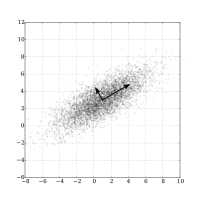
Photo from wikipedia
Background Conditional power of network meta-analysis (NMA) can support the planning of randomized controlled trials (RCTs) assessing medical interventions. Conditional power is the probability that updating existing inconclusive evidence in… Click to show full abstract
Background Conditional power of network meta-analysis (NMA) can support the planning of randomized controlled trials (RCTs) assessing medical interventions. Conditional power is the probability that updating existing inconclusive evidence in NMA with additional trial(s) will result in conclusive evidence, given assumptions regarding trial design, anticipated effect sizes, or event probabilities. Methods The present work aimed to estimate conditional power for potential future trials on antidepressant treatments. Existing evidence was based on a published network of 502 RCTs conducted between 1979-2018 assessing acute antidepressant treatment in major depressive disorder (MDD). Primary outcomes were efficacy in terms of the symptom change on the Hamilton Depression Scale (HAMD) and tolerability in terms of the dropout rate due to adverse events. The network compares 21 antidepressants consisting of 231 relative treatment comparisons, 164 (efficacy) and 127 (tolerability) of which are currently assumed to have inconclusive evidence. Results Required sample sizes to achieve new conclusive evidence with at least 80% conditional power were estimated to range between N = 894 - 4190 (efficacy) and N = 521 - 1246 (tolerability). Otherwise, sample sizes ranging between N = 49 - 485 (efficacy) and N = 40 - 320 (tolerability) may require stopping for futility based on a boundary at 20% conditional power. Optimizing trial designs by considering multiple trials that contribute both direct and indirect evidence, anticipating alternative effect sizes or alternative event probabilities, may increase conditional power but required sample sizes remain high. Antidepressants having the greatest conditional power associated with smallest required sample sizes were identified as those on which current evidence is low, i.e., clomipramine, levomilnacipran, milnacipran, nefazodone, and vilazodone, with respect to both outcomes. Conclusions The present results suggest that conditional power to achieve new conclusive evidence in ongoing or future trials on antidepressant treatments is low. Limiting the use of the presented conditional power analysis are primarily due to the estimated large sample sizes which would be required in future trials as well as due to the well-known small effect sizes in antidepressant treatments. These findings may inform researchers and decision-makers regarding the clinical relevance and justification of research in ongoing or future antidepressant RCTs in MDD.
Journal Title: BMC Psychiatry
Year Published: 2021
Link to full text (if available)
Share on Social Media: Sign Up to like & get
recommendations!